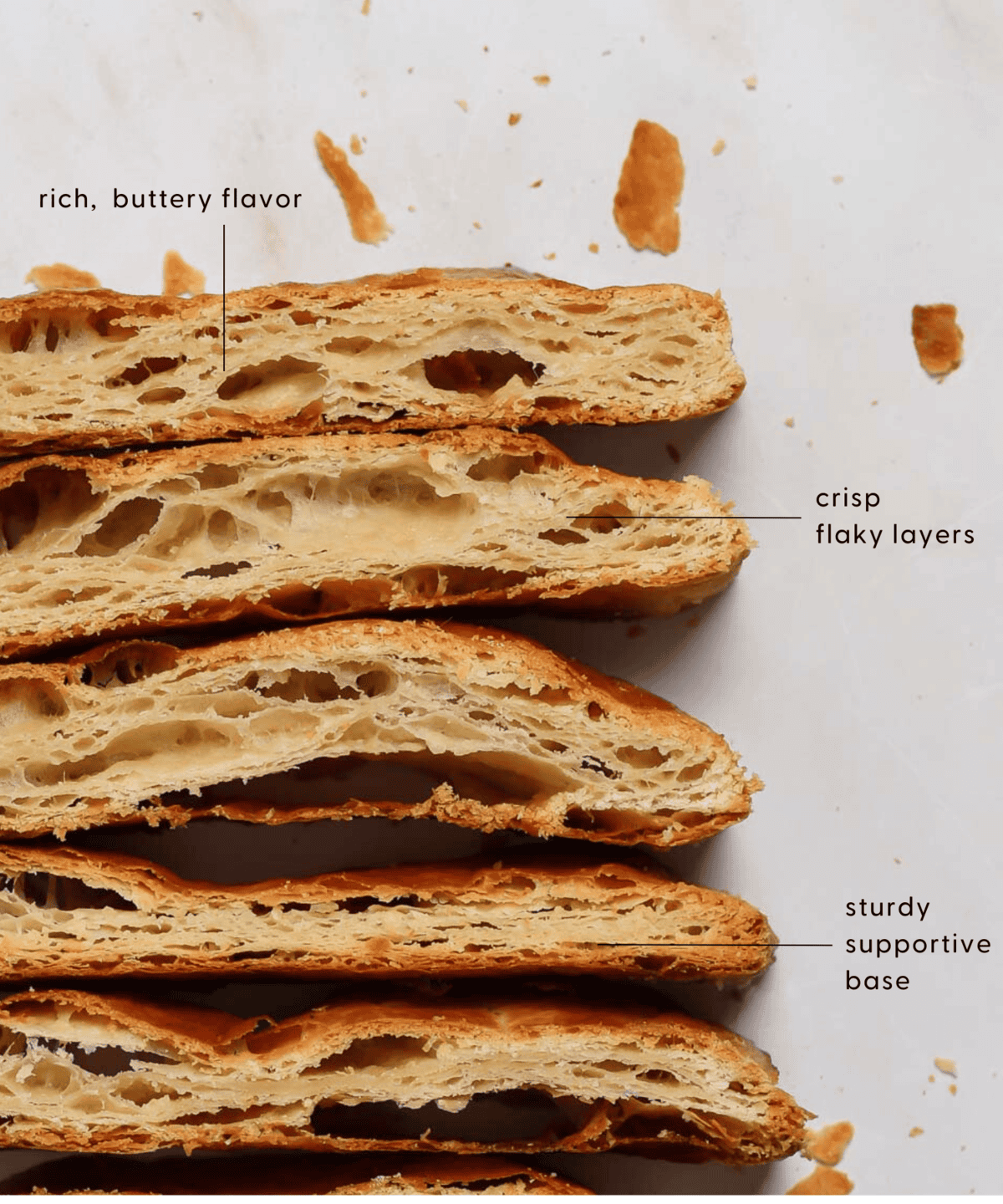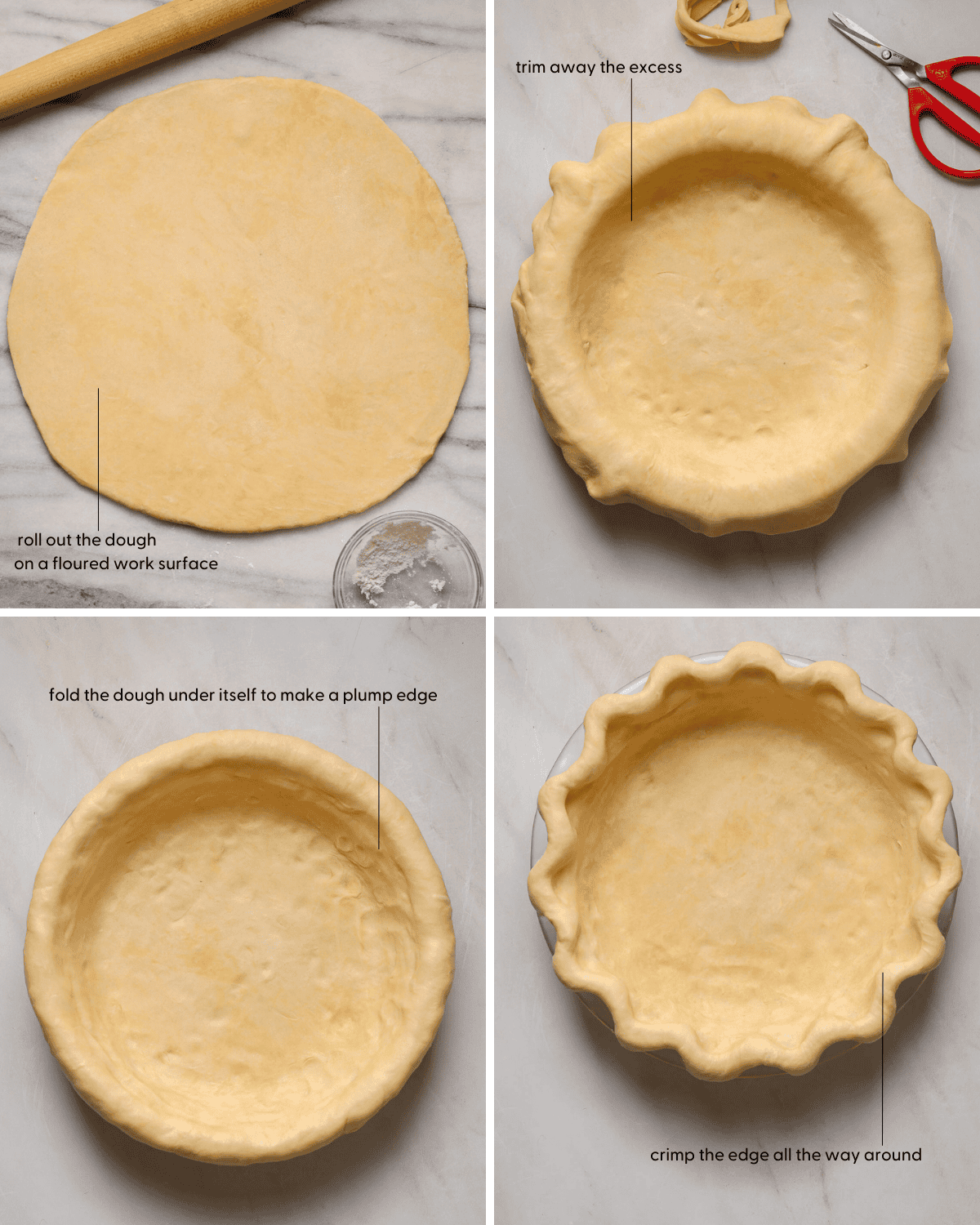Perfect Flaky Pie Crust (Two Methods)
Homemade pie crust has a reputation for being finicky and difficult but honestly – it’s really not. A perfectly tender, flaky pie crust is totally doable, even for the most novice home cook. Here’s my tried-and-true all butter pie crust recipe complete all the little tips and tricks I’ve picked up over the years.

Repeat after me “we will not buy st*re boug*t pie crust, we will not buy st*re boug*t pie crust, we will not buy st*re boug*t pie crust”. Phew, okay, now that that’s settled – let’s get down to business.
This is, for me, the consummate pie crust. It’s deceptively simple to make and bakes beautifully every time. It has a delicate crackly shell that shatters into a thousand sweet and salty golden flakes. Beneath that, layers and layers of tender, buttery pastry, supportive enough to hold any filling. (No soggy bottoms here!)
I’ve outlined below two methods for making pie crust – the ingredients stay the same no matter which method you go with. You can assemble your dough in a food processor or by hand with a pastry cutter. The results are the mostly same either way. The food processor is newbie-friendly and easy to scale if you need to make multiple batches of crust. Making it by hand is a labor of love and gives you a little more control over all.
I use this pie crust for everything – pies at Thanksgiving, sweet tarts, savory tarts, quiche, crostatas, galettes and so on.
Pie Crust Ingredients:
The ingredients are simple, you will need: all-purpose flour, cold butter, sugar, salt and ice water.
*See recipe card for additional notes and ingredient substitutions.*

A Note on Butter: European-style butters typically have a higher butterfat content than American butter. Using a high-quality European (or European style) butter will give your dough a noticeable boost in the final product, enhancing both the taste and texture of the crust. Kerry Gold is my recommendation, it has great buttery flavor, it’s widely available and not crazy-expensive.
Food Processor vs By Hand
- Pie Dough in the Food Processor – It’s quick and yields a very consistent pie crust. It’s my preferred method during the holidays when I need to make 4,5,6+ pie crusts at a time.
- Pie Dough by Hand – If I only need to make a single recipe I typically make it by hand. I love the meditative, tactile feeling of smashing the cold butter and flour together. You have a little more control with this method and as an added bonus you don’t have to to clean the food processor after. (One of my least-favorite chores – ha!)
How to Make Pie Crust:
By Hand:
- Combine flour, sugar and salt in a bowl. Use a pastry blender or clean fingers to cut the butter into the flour until the mixture resembles coarse crumbs with some pea-sized butter pieces.
- Add the liquid: Start with half the ice water mixture, use your hands to fold the dough just until it comes together. Turn out onto a floured surface.

Food Processor:
- Combine flour, sugar, salt, and butter in your food processor. Pulse until the mixture resembles coarse crumbs with some pea-sized butter bits remaining.
- Add the liquid: Start with half the ice water mixture then pulse pulsing just until the dough starts to come together. If needed, add more water, a few tablespoons. The dough should be shaggy with some visible bits of dry flour. Turn the dough out onto a floured surface.

Shape and Chill:
Now that you have your shaggy mass it’s time to shape it. Knead the dough once or twice, just until it comes together then divide it in half. Wrap each half tightly in plastic wrap then transfer to the refrigerator to chill until it’s very cold and firm, at least 2 hours. If a recipe requires only a single portion of dough, freeze the other portion and save it for another use.

Rolling and Crimping:
For an effortless roll out the dough must be cold. Must, must, must! Work quickly to prevent the dough from warming up. If it starts to get warm just pop in the freezer to chill for 5 minutes then you can get back to work.
Also, generously flour your work surface, rolling pin, and even your hands to prevent sticking. This ensures smooth rolling and easy handling. You can always brush away excess flour with a clean, dry pastry brush.

Blind Baking:
Blind baking is the process of par-baking the crust before you add the filling which helps to create a sturdy foundation for your filling. Like giving your pie crust a little head start.
Line your pie crust with parchment paper (or aluminum foil) and fill it with pie weights (or even dried rice or bean). This prevents the crust from puffing up like a balloon.


More
Helpful How-Tos
I love to hear from readers and always do my best to respond to each and every comment. If you make this recipe be sure to leave a comment and/or give it a rating! Don’t forget to follow along on Pinterest, Facebook, and Instagram for all the latest updates!

Perfect Flaky Pie Crust (Two Methods)
Ingredients
- 3 cups all-purpose flour
- 1 tablespoon sugar
- 1 teaspoon kosher salt
- 1 1/4 cups high-quality, unsalted butter - cut into 1-inch pieces, chilled
- 1/2 cup ice water
Instructions
Food Processor:
- Mix the dry ingredients: Place the dry ingredients into the base of the food processor and pulse 3-4 times until combined. Next, add the cold butter and continue pulsing until the mixture resembles coarse sand with some larger pea-sized chunks of butter.
- Add the liquid: Pour half the the ice-water (just the water, no ice) over the flour mixture. Pulse the dough together 2-3 times, just until starts to hold together. If it feels too dry, add a tablespoon or two of water, but remember – a slightly drier dough is what we're after. It'll hydrate as it rests.
- Knead and Chill: Turn the mixture out onto a floured work surface. Divide the dough in half and pat each half into a 1-inch thick disc. Wrap each disc separately and let them chill in the refrigerator for at least 2 hours. After two hours of resting your dough is ready to use. If a recipe requires only a single portion of dough, freeze the other portion and save it for another use.
By Hand:
- Mix the dry ingredients: In a large bowl, whisk together the flour, sugar, and salt.
- Incorporate the butter: Starting with a pastry blender, begin to cut the butter into the flour mixture. Once the the butter is mostly incorporated, switch to your fingers to flatten and smear any lingering large chunks of butter into the flour mixture. Aim for long, thin pieces to create those lovely flaky layers. Keep going until the mixture resembles coarse sand with some larger pea-sized chunks of butter.
- Add the liquid: Pour half the the ice-water (just the water, no ice) over the flour mixture. Mix the dough together with your hands just until starts to hold together. If it feels too dry, add a tablespoon or two of water, but remember – a slightly drier dough is what we're after. It'll hydrate as it rests.
- Knead and Chill: Turn the mixture out onto a floured work surface. Divide the dough in half and pat each half into a 1-inch thick disc. Wrap each disc separately and let them chill in the refrigerator for at least 2 hours. After two hours of resting your dough is ready to use. If a recipe requires only a single portion of dough, freeze the other portion and save it for another use.






